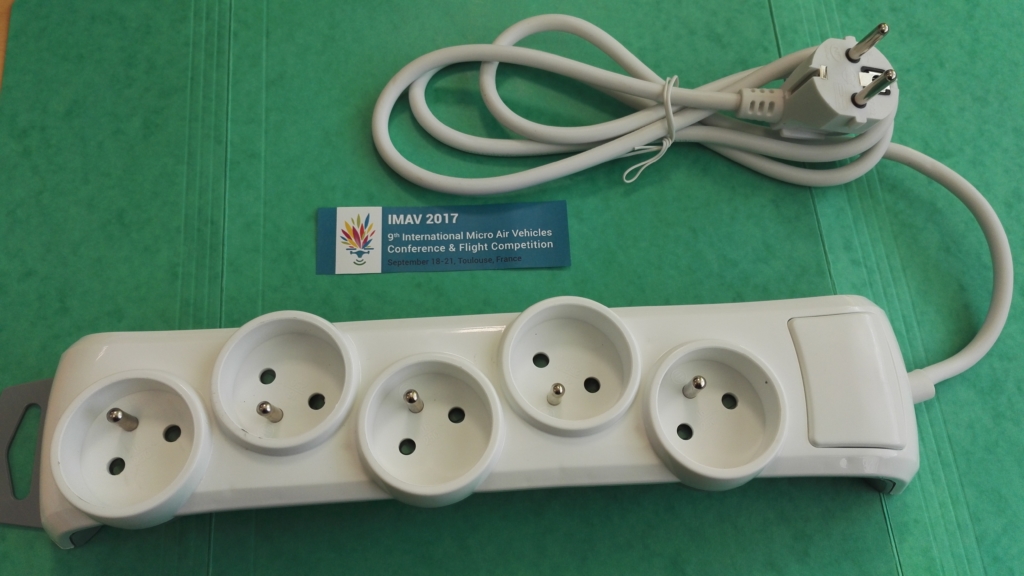COMPETITION RULES
The indoor and outdoor competitions are set up to highlight the following points :
- Aircraft efficient and innovative designs
- Small and light MAVs
- Autonomy and image processing
- Multi-UAV cooperation
COMPETITION RULES version 2.3
Safety and security requirements
- All participants are required to be familiar with the contents of the document and comply with it. Safety checks will be performed before each flight
- Due to regulation and safety, the maximum weight for all types of MAV is 2 kg and the maximum flight altitude is 30 m above ground level
- Safety areas are described in a Google Earth file (available soon) and the map in the outdoor competition section
- All MAVs should stay inside the flight area (green line). When crossing this limit, a MAV should either land or turn back immediately inside the flight area.
- The second border (red line) defines the border of the no-fly zone. Any MAV crossing this line should turn OFF its motors (fixed-wing aircraft may glide upon the control of the safety pilot and land as fast as possible).
- Allowed frequencies and maximum power:
- 26 MHz, 41 MHz, 72 MHz: max power 100 mW
- 433 MHz: max power 10 mW (10% duty cycle)
- 868 MHz: max power 25 mW
- 2.400 GHz to 2.483 GHz: max power 100 mW
- 5.7 GHz to 5.8 GHz: 25 mW
- The use of the 900 MHz frequency is not allowed
Failure to abide by the boundaries and frequencies can lead to a penalty or disqualification.
Location
The outdoor flight competitions will take place at Francazal airfield
The indoor flight competitions will take place at ISAE-Supaero
Competition slot: preparation time & flight time
Teams are not assigned a specific preparation time and a flight time but rather a competition slot. In this slot, they will set up their equipment, prepare the flights, fly the mission, and land all the MAVs. Failure to land all vehicles within the slot can lead to a penalty or disqualification.
The order of the teams’ slots will be randomly decided on the morning of the day of the competition. At any time, before or during the mission, a team can decide once, and only once, to postpone the rest of its mission. In this case, the rest of flight slot of the team is shifted to the end. Therefore, all teams must be ready to fly at any time.
Time slots are 15 minutes for the Indoor mission and 15 minutes for the Outdoor mission.
Scoring
The final score will depend on the success of the mission elements ( M = sum of the successful mission elements), the level of autonomy for each mission element ( A ), the size factor ( S ), the “in-a- row” factor ( I ), and a presentation made by the team during the mission ( P ).
Awards will be determined using the following formula:
- Total score = Sum each MAV (M x A x S x I) x P
In order to ease the jury’s task, the teams flying multiple MAVs shall clearly identify (color, number) each vehicle.
A task yields points only once. If several aerial vehicles perform the same task, the scoring will be applied to only one vehicle so as to maximize the overall scoring.
In addition, special jury prizes will be awarded.
Size factor (S)
The maximum size of the MAV is 1.5 meter, which is determined by:
- the wing span of the aircraft
- or the maximum horizontal distance of a rotary wing (including blades).
The maximum takeoff weight is 2 kg for all type of MAVs.
Size factor = 1/(size of the MAV in meter)
Level of autonomy (A)
The level of autonomy describes how a MAV is operated in order to fulfill the mission elements. The factor associated to each autonomy level is then used to compute the final score.
| Level of autonomy | factor |
|---|---|
| Video based control: control of the MAV is manual but out of line of sight (FPV) | 1 |
| Autonomous flight control: the navigation is completely autonomous but the operator is controlling the mission and the payload | 5 |
| Autonomous target detection: the navigation is manual but the detection and processing of the targets is automatic | 5 |
| Fully autonomous mission control: the navigation and the decision making are autonomous, without assistance of the operator | 10 |
| Using external aids such as visual markers | -2 applied to factor |
The video based control (factor 1) can only count for a single mission element (per MAV). If several mission elements are performed with this level of autonomy, only the best score will be kept (and other elements not taken into account).
Technical demonstrations are going to be a separate flight session with or without autonomy.
The main issue there is to illustrate a novel technique/strategy which does not fit with the tasks proposed. While they will not compete for the mission scores, they are eligible for the special jury prizes.
In-a-row factor (I)
The “in-a-row” factor encourages participant to complete as many mission elements as possible without stopping. The more mission elements completed in a single trial, the higher is the factor.
| Number of mission elements completed in a single trial | factor |
|---|---|
| 1 | 1.0 |
| 2 | 1.1 |
| 3 | 1.2 |
| 4 (Max) | 1.5 |
Presentation factor (P)
The team is rewarded when a team member presents the tasks and actions currently performed. The goal is to make the demonstration of each team more lively and accessible for the public. A video feedback of the ground station is also possible and is strongly recommended (standard VGA cable or analog video).
The presentation factor will be determined according to the description of:
- the MAV system and its design
- the initial plan to perform the mission elements
- the tasks actually performed
- the level of autonomy of each task / MAV
Presentation factor = 0 to 10 % of the total score (P from 1 to 1.1)
Mission elements (M)
A mission consists of multiple elements that can be performed in any order by one or more MAV. For each mission element, a score is awarded to the MAV that accomplishes the assigned task (see scoring tables further):
- a MAV can attempt to complete the mission element as many times as needed in the allotted time but only the best score will be used for the final scoring
- if several MAVs are doing the same mission element (including take-off and landing), only the best score is kept, except for the cooperative mission (in which case, all MAVs involved in the best attempt are considered in the final scoring)
See complete document or dedicated pages (indoor or outdoor) for details on the mission elements.
Teams’ scores will be calculated using the following Excel sheets.
Each team will be provided with an electric power strip 230V/50hz

Technological demonstration
The goal of this flight demonstration is to highlight novel disruptive MAVs architectures / technologies. RC-control mode may be accepted for the technological demo which may take place either during the indoor session or during the outdoor flight session.
Static exhibition
A static exhibition will be planned in order to show both prototypes and commercial MAVs to the participants.
